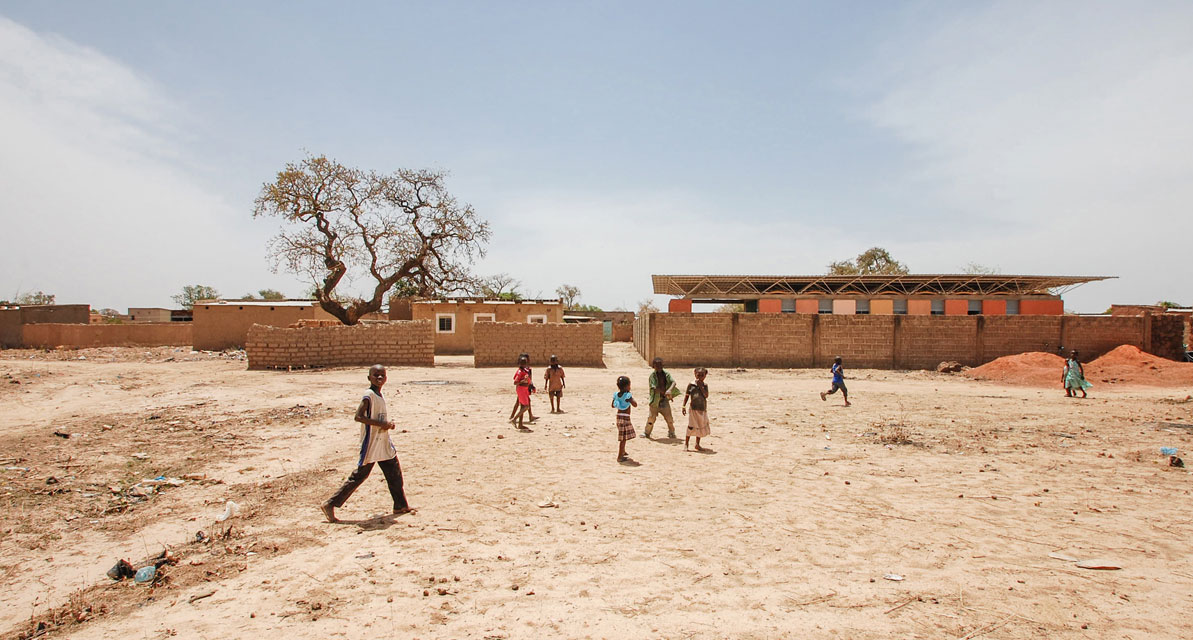
Boassa, vocational training centre for women
TECHNICAL DATA
Situation
Ouagadougou (BF)
Project
2014
Construction
2016
Surface area
275 m2
Client
Burkina Women's Association
Author
Fernando Agustí arquitecto / albertfaus architecture
Collaborators
Inés Agustí Brugarolas, Sandra Espinilla Espeso
Team
Marta Migliorini (estructura)
Photography
Giovanni Quattrocolo, Albert Faus
The project aims at building a professional training center for women. It is located in Boassa, a small ancient village, today a district in the periphery of Ouagadougou, capital of Burkina Faso. The equipment has to primarily allow needlework training, but also garden activities. Moreover, many of the attendees need basic alphabetization as well.
Boassa is a barely urbanized, not yet parceled up neighborhood. It is a labyrinth of dirt little alleys, lacking basic services such as potable water or electricity. The great majority of buildings one can find there are about twenty-square-meters precarious dwellings. Adobe-made walls (covered by thin metallic sheets) are raised above a first line of sand cement bricks which separates them from the ground and protect them from overflows.
The NGO Mujeres Burkina put forward the program. This consisted in a multi-purpose, diaphanous room for at least 40 students; an outdoor (but covered) classroom; an office for the responsible; a warehouse for educational materials and another one for tools; a bathroom; a kitchen; a well; an entrance cabin; a vegetable garden area; a green zone with Moringas (Moringa Olifera), useful for its medicinal and nutritional properties.
It has been decided to group the training room together with its warehouse, the office, and the restrooms in a main building. This space is located at the very end of the plot, opposite to the entrance, so as to free the most space up for cultivated areas (garden and moringa). The whole area is surrounded by a shaded terrace, which is particularly big in its main north façade. This east-oriented space results in a porch which is used as an exterior classroom, and which crucially serves as a shield against rainy-season winds. The rest of the program is concentrated around the plot entrance, with two small areas which exploit part of the pre-existing enclosures as well as the original entry space.
The construction refers to the place (area), both in proportion and in materiality. The main body shares common features both with school to the east and with the nuns’ house to the north. The secondary areas have similarities with the neighborhood’s houses. However, differently from what regularly happens there, building the training room demonstrated the proper use of adobe in a greater construction featuring a heavy roof. The building now seats above a wide concrete platform which protects it from humidity, and allows to go round it. Forty-centimeters-thick load bearing adobe-made walls sustain the weight of the upper ceiling, and at the same time improve the thermal and acoustic isolation. This space is mainly covered by a sequence of flattened vaults, made of CEB (Compressed Earth Block), borne by 7-meters-span reinforced concrete beams produced in situ. The building’s outer layer is a galvanized metal sheet which has been fixed onto a three-dimensional structure made of a circular-section metallic tubular. This metallic structure is conveniently anchored to the reinforced concrete beams, thus converting them (as it is required) in sort of compounded beams. The upper metallic sheet allows obtaining a ventilated roof and protecting the building below both from direct sunlight and the intense summer rainfalls.
The interior surfaces of the adobe walls are finished with a lime mortar coating, being the exteriors and the vaults plastered with different tonalities of clay from coming from nearby quarries, which gives an attractive and colorful final image to the main building.
Awards
Finalist at FAD International Architecture Award 2018.
Honourable Mention in Architectural Design/Educational Buildings, The Architectural Masterprize 2018.
